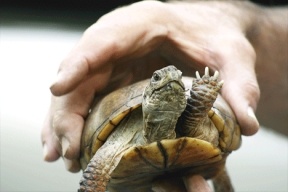Wayward turtle could be used for breeding
Turns out that “Lucky” the turtle is quite a catch. And if the wandering reptile of Sills Road shows up again, he may have a love connection in his future.
“Lucky” the turtle made news last month when three Clinton residents found him crawling along Sills Road and rescued him from his precarious position on the side of the busy roadway.
Ruth Milner, a district wildlife biologist for the state Department of Fish and Wildlife, saw the story about the turtle in The Record and hopes he will make another public appearance.
Milner said the turtle is a western pond turtle, a rare reptile that’s on Washington’s endangered species list and is a candidate for the federal list.
If Lucky can be found and captured, Milner said he will be placed in the state’s captive breeding program for turtles at the Woodland Park Zoo in Seattle.
In fact, you could say that the state would be lucky to get Lucky.
“It’s a smallish gene pool,” Milner said. “The turtles we have in the captive breeding program came from a couple of sites down in the Columbia River Gorge.”
Milner, who began her career as a state biologist by looking for the western pond turtle, said the western pond turtle was once found as far north as Lake Washington and was pretty common in the wetlands around Fort Lewis and McChord Air Force Base.
“That whole general vicinity was once a really impressive wetland complex,” she said.
Over time, however, many wetlands have been filled or reduced in size and quality as the region has been developed.
“And that may be why the turtles are no longer found in this region in central and northern Puget Sound. They may not have been very abundant to begin with,” Milner said.
Although a western pond turtle was found last year in Anacortes, reports of them at the northern edge of their range aren’t common.
“We’ve never found a population up here,
we find individuals, often in odd places like Whidbey Island,” she said. “Who knows where this guy came from or why it was wandering.”
“They do wander,” Milner added. “They get up and truck over land.”
The western pond turtle is easy to distinguish from painted turtles or the red-eared sliders.
Painted turtles are bright orange on their bottom shells, and red-eared sliders are easy to spot, as well. “They have an all cream colored belly plate,” she said, and black spots on the edge of the shell.
“The western pond turtle is the glamorless one of the group,” she said. It has a dull shell and no flashy colors.
Even so, the search for Lucky continues.
“So far it sounds like no one has seen it again,” Milner said. “By all means, folks in the Bayview area can keep an eye out for it.”
The obvious thing to look for, she said, is a turtle basking on a log or the edge of a pond.
The state has captured turtles for the breeding program in the past by trapping them, using what looks like a giant crawdad trap.
Although the odds are low that Lucky will be found again, Milner said people should try to catch him or call the state if he is seen again.
“If they can grab it and put it in a bucket where it can crawl out of the water if it wants to, but not out of the tub,” she said.
The western pond turtle was put on the state’s state endangered species list in 1993, after the number of turtles had dropped to about 150 statewide. Milner said if people see a turtle, they should contact her at milnerlm@dfw.wa.gov.



